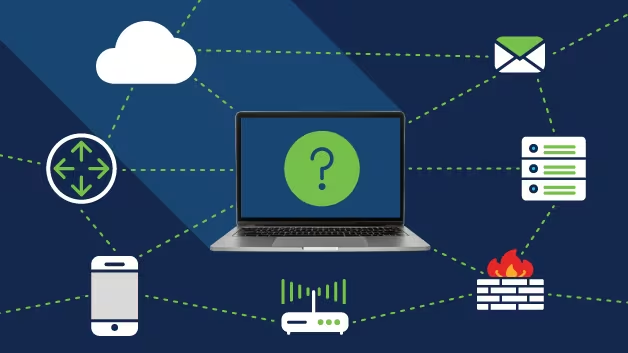Description :
A cutting-edge tech startup in Silicon Valley faced potential data breaches due to unpatched servers. Valency Networks, a globally recognized VAPT expert, conducted an exhaustive analysis, revealing vulnerabilities that could compromise groundbreaking innovations.
How Valency Networks Helped As a Cyber Security Expert?
Valency Networks initiated a thorough penetration testing (pentesting) strategy, meticulously assessing server vulnerabilities through comprehensive cyber security audits and network audits. The team meticulously identified and prioritized the critical issues, implementing strategic patching measures and reconfiguring server settings for optimal security. Continuous monitoring solutions were deployed to ensure ongoing protection against evolving cyber threats. Valency Networks emerged as a cybersecurity expert, combining pentesting methodologies with tailored solutions, safeguarding the tech startup's intellectual property.
Case Study : Healthcare Guardian
Industry:
Healthcare
Country:
Germany
Challenge:
Desktop Security and Ransomware Threat
Description:
A leading healthcare provider in Germany faced the looming threat of ransomware due to weaknesses in desktop security. Valency Networks, a highly awarded VAPT company, conducted a meticulous assessment, revealing vulnerabilities that could compromise patient records.
How Valency Networks Helped As a Cyber Security Expert?
Valency Networks performed an extensive cybersecurity audit, incorporating penetration testing to assess desktop security comprehensively. This involved identifying potential entry points for ransomware attacks and evaluating the effectiveness of existing security measures. Through a detailed network security assessment, Valency Networks identified and remediated vulnerabilities, implementing advanced endpoint security solutions. The healthcare provider recognized Valency Networks as a cybersecurity expert adept at safeguarding sensitive healthcare data.
Case Study : Financial Fortification
Industry:
Financial Services
Country:
Singapore
Challenge:
Network Switch Vulnerabilities
Description:
A major financial institution in Singapore faced disruptions due to vulnerabilities in network switches. Valency Networks, a globally awarded VAPT expert, conducted a comprehensive assessment, revealing weaknesses that could compromise critical financial transactions.
How Valency Networks Helped As a Cyber Security Expert?
Valency Networks executed an in-depth network security audit, employing penetration testing techniques to identify vulnerabilities in network switches. This involved assessing configurations, traffic patterns, and potential attack vectors. The findings were meticulously addressed through strategic patching, network segmentation, and the implementation of advanced security measures. Valency Networks emerged as a cybersecurity expert, fortifying the financial institution against cyber threats.
Case Study : Retail Startup Resilience
Industry:
Retail
Country:
India
Challenge:
Operating System Vulnerabilities
Description:
A burgeoning retail startup in India faced security gaps in its operating systems, exposing customer data to potential breaches. Valency Networks, a recognized leader in VAPT, conducted an in-depth analysis, identifying risks associated with unpatched systems.
How Valency Networks Helped As a Cyber Security Expert?
Valency Networks conducted a thorough penetration testing process, evaluating operating system vulnerabilities through comprehensive cyber security audits. This involved assessing patch levels, system configurations, and potential avenues for exploitation. Valency Networks strategically applied timely OS patches, enhanced intrusion detection systems, and conducted targeted employee training on cyber hygiene. The retail startup, now prioritizing cybersecurity, hailed Valency Networks as a cybersecurity partner employing advanced pentesting methodologies.
Current Network Security Trend and Urgency
In the dynamic landscape of cybersecurity, staying abreast of current network security trends is paramount to effectively safeguarding organizations against emerging threats. At Valency Networks, we are committed to helping our clients navigate the ever-evolving cyber threat landscape by providing insights into the latest trends and urgencies in network security.
One prevalent trend in network security is the proliferation of remote work environments, driven by the COVID-19 pandemic. With a significant portion of the global workforce transitioning to remote work, organizations face heightened security challenges associated with securing distributed networks and endpoints. According to research conducted by Cybersecurity Ventures, remote work-related cyber attacks are expected to cost businesses $6 trillion annually by 2021, underscoring the urgency of implementing robust security measures in remote work environments (Cybersecurity Ventures, "2021 Cybercrime Report").
Moreover, the rise of cloud computing and adoption of Software-as-a-Service (SaaS) applications have introduced new complexities to network security. Organizations are increasingly migrating their infrastructure and applications to the cloud, necessitating robust security controls to protect sensitive data and mitigate the risk of unauthorized access. According to the "2020 State of the Cloud Report" by Flexera, 93% of enterprises have a multi-cloud strategy, highlighting the pervasive adoption of cloud technologies in modern IT environments (Flexera, "2020 State of the Cloud Report").
Another emerging trend in network security is the convergence of IT and Operational Technology (OT) systems, driven by the proliferation of Internet of Things (IoT) devices and Industrial Internet of Things (IIoT) applications. The interconnectivity of IT and OT environments presents unique security challenges, as vulnerabilities in IoT devices and industrial control systems can potentially compromise critical infrastructure and disrupt operations. Research conducted by Trend Micro found that the number of vulnerabilities in IoT devices increased by 100% in 2020, emphasizing the urgent need for robust security controls in IoT deployments (Trend Micro, "2020 Annual Cybersecurity Report").
Additionally, the threat landscape is constantly evolving, with cybercriminals leveraging advanced techniques such as artificial intelligence (AI) and machine learning (ML) to evade traditional security defenses. According to the "2021 SonicWall Cyber Threat Report," there was a 62% increase in ransomware attacks in 2020, with cybercriminals increasingly utilizing AI-driven tactics to launch sophisticated attacks (SonicWall, "2021 Cyber Threat Report").
In conclusion, at Valency Networks, we recognize the urgency of staying abreast of current network security trends and proactively addressing emerging threats. By understanding the dynamics of remote work environments, cloud adoption, IoT proliferation, and evolving cyber threats, organizations can enhance their security posture and mitigate the risk of cyber attacks. Partnering with expert network VAPT companies like Valency Networks can provide organizations with the expertise and insights needed to navigate the complex landscape of network security and safeguard their digital assets against emerging threats.








